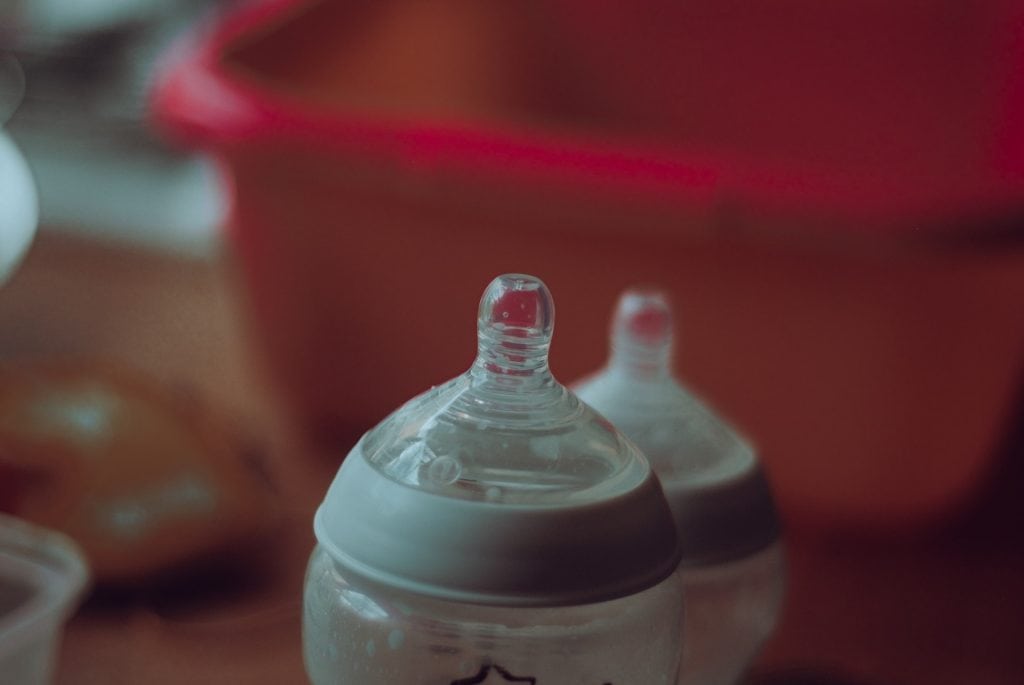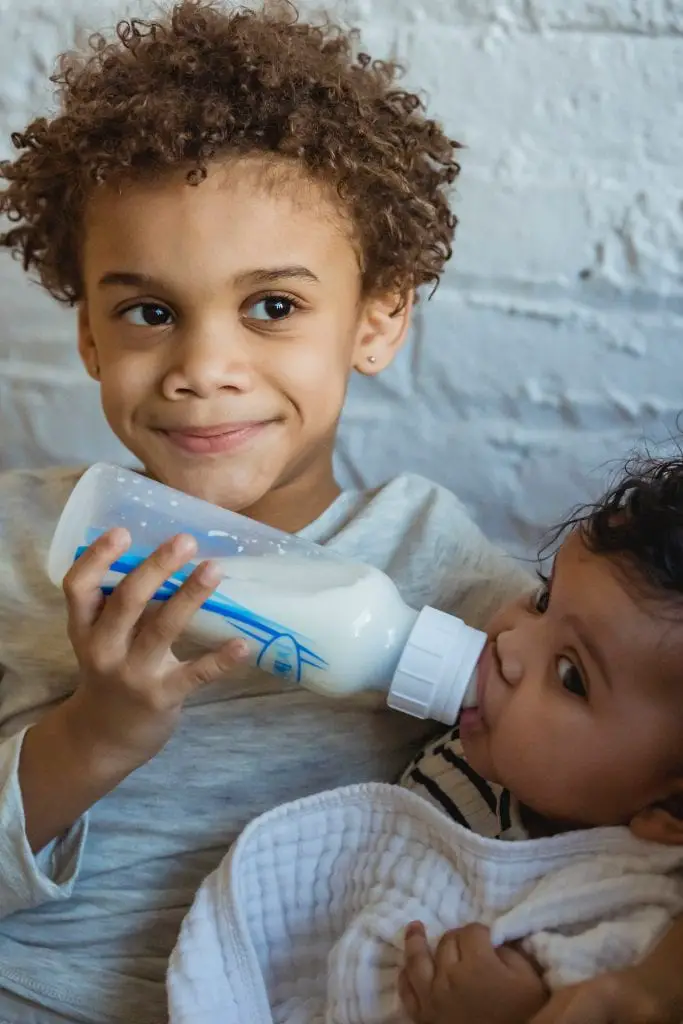If there’s one feeding item every parent needs to consider changing over time it would be baby bottles and nipples. But, it does raise the question of how often baby bottles should be changed. In the first year or so of bottle feeding your baby, the bottles and nipples are used many times over.
It’s recommended to change your baby bottles every three to six months. Whether you’re using a premium baby bottle brand or not, it’s advisable to regularly replace old bottles. This means you’ll be replacing your baby bottles two to four times a year before switching to solids.
Which One is More Important to Replace: Nipples or Bottles?
Is it more important to replace nipples more regularly than bottles? After all, the nipples are more prone to wear and tear with constant sucking! Both manufacturers and health experts do agree that nipples should be changed often and that it’s more important than replacing the actual bottle.
Manufacturers of well-known brands recommend changing nipples every two to three months. Health experts go as far as recommending changing the nipples every three months to avoid any serious problems developing when bottle feeding your baby.
Signs a Nipple Should Be Changed Because of Need for a Different Size

How do you know it’s time to change nipples to a different size? The common nipple sizes are labeled as Level 0, Level 1, Level 2, Level 3, and Level 4. Baby bottle manufacturers use age as a guideline for choosing the right nipple size for your baby.
Nipples are designed to suit the baby’s ability to drink milk at a certain flow rate. It’s generally expected that smaller babies take milk at a much slower rate than older babies. The different levels account for this by categorizing the nipple sizes according to the baby’s age and natural feeding development at that stage.
Use the following guidelines recommended by baby bottle manufacturers when deciding what teat size you should use depending on your baby’s age:
- Slow flow: Level 0 for preemies and Level 1 for newborns from one to three months old.
- Medium flow: Level 2 to 3 for babies ranging from three to six months and older.
- Fast flow: Level 4 for babies older than nine months old.
While age is a general guideline used to decide on what nipple size you should use, always look out for other signs your baby needs a different teat size.
Signs Your Baby is Ready for Another Teat Size
Every baby is different and age doesn’t always determine their preferred flow rate. The best sign indicating it’s time to change to a different teat size is how your infant is coping with the flow of milk or formula during feeding.
Look out for the following signs indicating it could be time your baby is ready for another teat size:
- Hitting the bottle: Your baby may be getting frustrated with the flow of milk being too slow.
- Gagging or choking: This could be a sign the milk flow rate is too fast for your baby.
- Swallowing forcefully or gulping: This is also a sign the flow rate is too fast.
- Falling asleep before finishing the bottle: If this happens it could mean the flow rate is too slow.
- Tugging at the nipple: This is another sign your baby is finding the flow rate too slow.
It’s essential to note that breastfeeding babies cope better with a slower flow no matter their age. So, if you’re switching from breast to bottle feeding, stay with a Level 1 nipple. Replacing a normal bottle with a bottle for tongue-tied babies, which I wrote about here, may also be another reason you need to change the nipple size as these babies need a paced flow rate.
Signs a Nipple Should Be Changed Because of Change in a Teat’s Quality
Discoloration
One of the key warning signs of a deteriorating teat is the change in color. The discoloration is an indication that the material is breaking down due to wear and tear from feeding and constant washing. Here’s an article I wrote about regarding nipples turning yellow.
Thinning
When the nipple starts to thin, it’s time to replace it with a new one. Thinning is also an indication of the material breaking down. To determine if a teat is thinning, tug at the bulb and release. If it bounces back to its original state, it’s still in good condition. However, if it doesn’t it’s time to toss it.
Swelling or Stickiness
Have you noticed the nipple is sticky every time you touch it? Then it’s time to replace it with a new one. Stickiness is an indication that the nipple material is starting to wear out from constant use. Swelling of the nipple is also a sign the material is deteriorating.
Nipple Becoming Flat, Not Holding Its Shape
When a nipple starts to deteriorate from wear and tear or it’s damaged, it often loses its original shape. Instead, it becomes flat or inverts during feeding. When this happens, you need to get new teats.
Breast Milk or Formula Rushes Out Through the Teat
If the breast milk or formula rushes out through the teat during feeding, the hole is too big. This could be the result of the hole being torn or the level size is wrong. Either way, you need to replace the nipple to prevent the milk from rushing out too fast.
Cracks, Breaks, Tears
Always check the teats for cracks, breaks, or tears in the build material. Loose pieces are hazardous for your baby and could cause choking. Swallowing pieces of teat material is also unhealthy for your baby. Cracks and tears may also harbor germs.
Signs a Bottle Should Be Changed
Bottle Expires
Parents do wonder if there are baby bottle validity dates included on these feeding items. However, most manufacturers don’t include an expiry date and rather simply recommend replacing bottles when there are signs of deterioration or damage.
Bottle’s Color Changing
When the baby bottle’s color starts to change, it’s time to consider getting new ones. The discoloration is often a sign that the materials used to construct the bottle are starting to deteriorate. However, bear in mind that if you’re using the bottles to give your baby fruit or vegetable juice, discoloration could be caused by the food’s pigmentation.
Cracks, Breaks, Chips in the Bottle Becomes Visible
Always be on the lookout for signs of cracks or chips in the bottle. These signs often start to show after heavy usage of the bottles or the build material is starting to break down. A cracked or chipped glass bottle is particularly hazardous and should be replaced immediately. Cracked or chipped plastic feeding bottles can also cause serious injury such as pinching or cutting of your baby’s fingers.
Bottle turns out to be disliked by your baby
Similarly to the fact that some babies don’t take some pacifiers, they might not like certain bottle types or certain brands. This is why I’m a big fan of testing different bottles and if some don’t prove to be good enough, then simply take it back and exchange it for another brand or simply sell your bottles.
How Often Should Plastic Baby Bottles Be Replaced?
It’s recommended to replace non-BPA-free bottles every three months. BPA-free plastic bottles can be changed every four to six months. However, plastic baby bottles can deteriorate faster than glass or silicone types so look out for signs of deterioration even in premium brands.
Other Bottle Accessory to Replace
Something many bottle-feeding parents don’t consider replacing is the disposable liners. If you’re using this accessory when bottle feeding, make sure you’re replacing them when you should be!
Disposable Liner
When choosing a baby bottle type for your baby you may come across disposable bottles. These are wonderful to use occasionally, especially when you’re traveling. The reusable plastic bottles are lined with a disposable liner which needs to be replaced after every feed.
While this is a convenient method of feeding when you don’t have easy access to cleaning bottles regularly, the liners are costly. Playtex Baby Nurser bottles do use recyclable disposable liners, making them more environmentally friendly while being convenient for nursing moms. Here’s an article I wrote about whether you need bottle liners.
When to Replace Popular Brands’ Baby Bottles
If you’re feeding your little one with a popular brand baby bottle, you may be wondering if you need to replace them as often as every three to six months. Let’s take a look at the well-known brands and find out when you should be replacing their baby bottles.
When to Replace Avent Baby Bottles
Avent baby bottles should be replaced as soon as there are signs of deterioration. This includes discoloration, cracking, or other damage to the material. Avent bottles are made with BPA-free materials so you can safely use these bottles for up to six months. However, the manufacturers do strongly recommend changing the nipples every three months.
When to Change Tommee Tippee Bottles
Tommee Tippee bottles don’t have expiry dates but following the general guideline of replacing bottles every three to six months can apply to this brand. These plastic baby bottles are made with BPA-free materials so changing every six months is also fine.
You should look out for signs of deterioration or damage and replace them immediately. According to the manufacturer’s guide to teats, they recommend changing the nipples every two months.
When to Replace Dr. Brown Bottles

Both Dr. Brown’s plastic and glass, such as blue or green Dr. Brown bottles, are made with BPA-free materials. This means you only need to replace them every four to six months unless they’re damaged in which case, immediately. Here’s an blog post I wrote which is about BPA-free bottles.
The manufacturers recommend checking Dr. Brown’s nipples every two to three months for signs of deterioration or damage before replacing them.
When to Replace MAM Bottles
MAM baby bottles are free of any plasticizers and are free of BPA toxins. This means you can safely use their bottles for up to six months unless they’ve been damaged or show signs of deterioration.
The manufacturers do recommend changing the bottle nipples at regular intervals, every one to two months.
Final Thoughts
When deciding how many baby bottles you’ll need, bear in mind they need to be replaced at least every six months even if you’re using premium brands. This way, you can rest assured your baby is drinking from a hygienic bottle, free of any problems normally caused by wear and tear.
